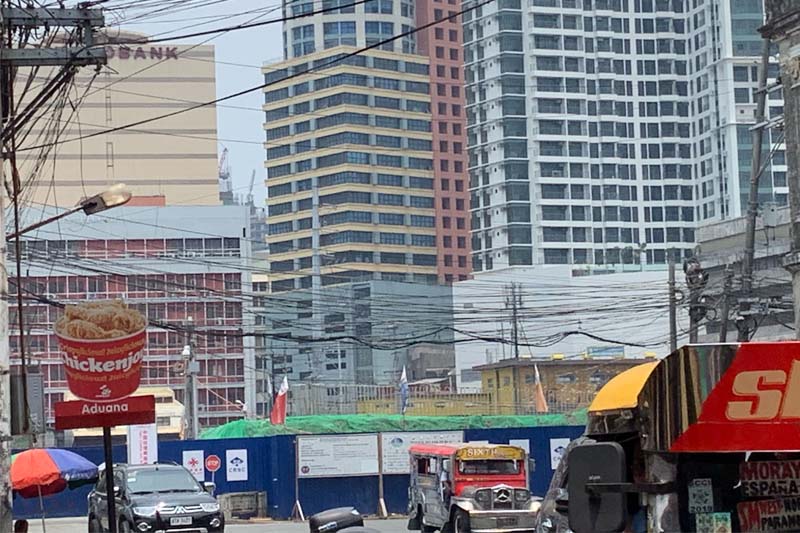Bridge burning bridges: Why the China-funded Binondo-Intramuros structure is controversial

MANILA, Philippines — It is unclear where a bridge symbolizing the fusion of two cultures—or ties of two states—is leading, as its construction faces opposition from local and international organizations and from some government agencies.
The construction of China-funded Binondo-Intramuros "Friendship" Bridge last year made headlines as the proposed project is feared to overstep the edge of the San Agustin Church’s buffer zone in the walled historic area of Intramuros in Manila.
Encroachment of the buffer zone, required by the United Nations Educational, Scientific and Cultural Organization, could lead to the delisting of the church and three other baroque churches in the country as world heritage sites.
The San Agustin Church, officially known as the Church of the Immaculate Conception of San Agustin, was inscribed as a World Heritage Site in 1993 under the serial declaration of the Baroque Churches of the Philippines. It is Manila’s sole UNESCO World Heritage Site.
The three others recognized by UNESCO as world heritage sites are San Agustin in Paoay, Ilocos Norte; Nuestra Señora de la Asuncion in Santa Maria, Ilocos Sur; and Santo Tomas de Villanueva in Miag-ao, Iloilo.
The church defines "the whole of Intramuros as its buffer zone, and it was approved by the World Heritage Center in 2013," according to the National Commission for Culture and the Arts’ report on the conservation status of the San Agustin Church.
Presidential spokesman Salvador Panelo last November attempted to assure the public that Malacañang would not allow the Binondo-Intramuros "Friendship" bridge to diminish the status of centuries-old churches there.
However, Panelo also said the Palace is not likely to object to the construction of the bridge but would just see how to adjust to keep baroque churches' protected. He added the Duterte administration does not see any issue with the bridge.
Other agencies, however, are more cautious despite Malacañang's nonchalance. The NCCA on April 25 said it has not given any recommendation yet on the already controversial bridge.
“We are waiting for the submission of the archeological assessment and the heritage impact assessments. So until this time, we’re waiting for the studies; then after that, we are going to decide because as of this time, we have not yet given the clearance of course,” Fr. Harold Rentoria, NCCA commissioner for cultural heritage, said at a Palace briefing on Thursday.
UNESCO National Commission of the Philippines Secretary General Lila Shahani previously told Philstar.com that a conservation status report from the NCCA was submitted to UNESCO in Paris, France only last December.
'Friendship' that drew disagreement
The month prior to the Palace's statement, however, the UNESCO World Heritage Center already questioned the proposal on the friendship bridge. It noted that the structure would pass over the Pasig River and would connect San Fernando Street in Binondo to Solana Street and Riverside Drive in Intramuros, thereby affecting area allotted for a declared heritage site.
“The proposed bridge would affect the edge of the San Agustin Church’s buffer zone at the north-east side, specifically on the Riverside Drive and Solana Street where the two separated ramp will align,” the executive summary of the NCCA’s conservation status report read.
“The project was alleged to bring additional traffic volume that might affect the Outstanding Universal Value of the church,” it added.
International Council on Monuments and Sites Philippines, in the same month, released a 10-page position paper opposing the construction of the bridge and enumerated the hazards in the structures in its vicinity.
Other stakeholders also came up with a position paper opposing the bridge. The Chamber of Commerce of the Philippines argued that the bridge would destroy its historical building as well as the historical environment of Intramuros—including the Plaza de Mexico Park and Monument, Intendencia and Puerta Isabel Monument—and its walls.
It said that the Chamber of Commerce of the Philippine Islands building is protected by Republic Act 10066 or the National Cultural Heritage Act of 2009.
This law prohibits modification, alteration or destruction of the "the original features of or undertakes construction or real estate development in any national shrine, monument, landmark and other historic edifices and structures, declared, classified, and marked by the National Historical Institute as such, without the prior written permission from the commission (NCCA)."
"This includes the designated security or buffer zone, extending five (5) meters from the visible perimeter of the monument or site," the law added.
“The Chamber of Commerce of the Philippine Island Site and Structure, along with Intramuros, is our national heritage and national patrimony as a people and country. It is the soul of who we are as a nation. It must therefore be protected and revered,” the position letter read.
The CCPI, which started since the Spanish era, also cited the comment of architect Joel Rico, president of the Guild of Philippine Architects in Conservation, who finds the bridge “poorly conceived.”
The group expressed concern on the possible worsening of the state of Pasig rivers and impact on the heritage sites.
Meanwhile, Cecilia Sunico, senior consultant at Martial Law Memorial Commission, who also participated in the stakeholders’ meeting, wanted to rally the significance of history and heritage.
“Collective memory is now gone,” she said.
Senate Minority Leader Franklin Drilon last November also filed Senate Resolution 944 calling on a Senate panel to conduct a probe into the issues surrounding the construction of the controversial Binondo-Intramuros bridge.
Amid the ongoing query of the World Heritage Center and other groups opposing the construction, the NCCA said various steps are being undertaken to address the potential impact of the project.
The NCCA said the Intramuros Administration, that has the authority to control the vehicle traffic and volume inside and passing through the walled city, assured the agency that it would only allow light vehicles inside. The culture and arts commission added that the Intramuros Administration is doing a conservation management plan for the area.
Officially 'halted' for now
The Department of Public Works and Highways, the implementing agency of the construction of the bridge, is also undertaking an Archaeological and Heritage Impact Assessment or AHIA and has ordered a pause in the construction. The DPWH Unified Project Management Office – Roads Management Cluster is in charge of the project.
“The AHIA would help this Commission and the other cultural agencies to clearly identify the impact of the project to San Agustin’s OUV," the NCCA said in its report.
“In addition, the project is presently on temporary work stoppage as DPWH is undertaking major design changes to the project as a result from discussions with cultural agencies to minimize the effect of the project to the country’s cultural heritage," it added.
San Agustin’s management also told Philstar.com about the halting of construction, noting that there was an excavation ongoing. It added that it has not been updated on the status of the construction yet.
NCCA’s Rentoria reiterated this at the Palace briefing on Thursday. He added that studies were promised to be accomplished by this month.
“So, we—DPWH, I know that they have suspended the work for the meantime while waiting for the completion of the studies where they are requiring it,” Rentoria said.
But actually underway?
A document obtained by Philstar.com in early April, however, indicated that the construction of the bridge already resumed.
A letter from the National Mapping and Resource Information Authority dated March 12, 2019 indicated that there is ongoing construction in the “vicinity of Binondo-Intramuros, Manila along Pasig River from March 2019 to December 2019.”
“All ships or watercrafts transiting the vicinity of the above mentioned areas are advised to take note of the information and take the necessary precautionary measures at all times,” NAMRIA advised.
The letter was signed by NAMRIA Hydrography Branch Director Commodore Jacinto Cablayan.
Philstar.com reached out to the DPWH and the National Museum to confirm if the AHIA was already completed and the construction works have resumed. However, the two agencies have not responded as of press time.
The construction site of the bridge is currently enclosed by perimeter fencing as observed during a recent visit of Philstar.com.

To ease traffic, but to what cost?
The deal to construct the Binondo-Intramuros was finalized in 2017, a year after President Rodrigo Duterte assumed office and took a softer stance toward China despite tensions over its encroachment and militarization of the South China Sea, considered the backyard of the Philippines.
The Binondo-Intramuros Friendship Bridge as well as the Estrella-Pantaleon Bridge projects, eyed to ease traffic congestion in Metro Manila, were approved by the National Economic and Development Authority board on Sept. 12, 2017. The implementation agreement or grant agreement was signed in November 2017 during the visit of Chinese Premiere Li Keqiang.
Secretary Mark Villar of the DPWH welcomed this agreement and thanked the Chinese government for committing to the Duterte administration’s “Build Build Build” project.
The two bridges are funded through China's grant amounting to 66.18 million yuan or P5.1 billion. The grant is capped at that amount while excess expenses will no longer be shouldered by China and its contractor China Road and Bridge Corporation.
“The Binondo-Intramuros Bridge is a P4.607 billion-steel bow-string arch bridge with intersecting reclining arches connecting Intramuros (at Solana Street and Riverside Drive) and Binondo (at San Fernando Street),” Villar said in previous reports, adding that it spans up to 807 meters.
The bridge broke ground on July 17, 2018 but the public disclosure of the contract indicated that the project started August 20, 2018 and is set to be completed on Feb. 19, 2021. The construction consultant of the project is China-based firm CCCC Highway Consultants Co. Ltd.
Assistant Secretary Antonio Lambino, spokesperson of the Department of Finance, said in March that 88 highly technical workers from China are working on the Estrella-Pantaleon and Binondo-Intramuros Bridges.
Citing stronger "uninterrupted friendship" and economic boost the project will inspire, the Federation of Filipino Chinese Chambers of Commerce and Industries expressed support for the China-funded project. It urged the public to make “short-term sacrifices and adjustments” for this, believing it would later on decongest traffic.
“We support the Binondo-Intramuros Bridge project, since it shall contribute to Manila’s urban renewal. It shall enhance our capital city’s tourism and cultural attractions, by making pedestrian and transport access to these two most historic districts much easier, more efficient,” the FFCCCII said in a statement in August 2018.
Ana Ugarte of the CCPI remains unconvinced about the project's purpose, whether it be to build bridges for the bilateral relations with China or to ease traffic. Her group asked:
"Can’t the existing bridges be improved instead of building new bridges? Can’t traffic be redirected instead? Can’t other laws be implemented or other plans be considered?"
Searching for an appropriateness certification
Philstar.com requested for the certificate of appropriateness, defined as a document "required for work that would change the exterior appearance of a designated historic property," from the Intramuros Administration through the Electronic Freedom of Information Program. However, the Intramuros body said it does not have one since the DPWH is the lead implementing agency.
The DPWH, meanwhile, granted our FOI request but has yet to respond whether it has a copy of the certificate.
Despite threats the bridge poses to the heritage status of the baroque churches, however, NCCA’s Rentoria said it is still not yet clear whether the churches would be delisted.
“I cannot say that as of this time, because we’re waiting for the studies. There are a lot of questions but it’s hard to answer unless we have the basis,” Rentoria said in mixed Filipino and English.
“We appreciate the projects of the administration in easing the traffic. So they submitted to us some studies they conducted and how this bridge will help the traffic in Metro Manila. But the priority, the concern of the cultural agencies is iyong San Agustin Church – will the outstanding universal value of the San Agustin Church be affected when the bridge is constructed? So until this time, we cannot say that it’s really affected or not because we’re waiting for these studies,” he added.
Rentoria, assured the public, that the agency is not going to allow the delisting of the four baroque churches.
READ: Palace promises China-funded bridge will not affect heritage churches
The UNESCO World Heritage Center is set to hold the 43rd World Heritage Committee Session in Baku, Azerbaijan from June 30 to July 10, 2019. It has not yet confirmed whether the Philippines will raise the heritage conservation issue of the baroque churches at the sessions.
- Latest
- Trending






























